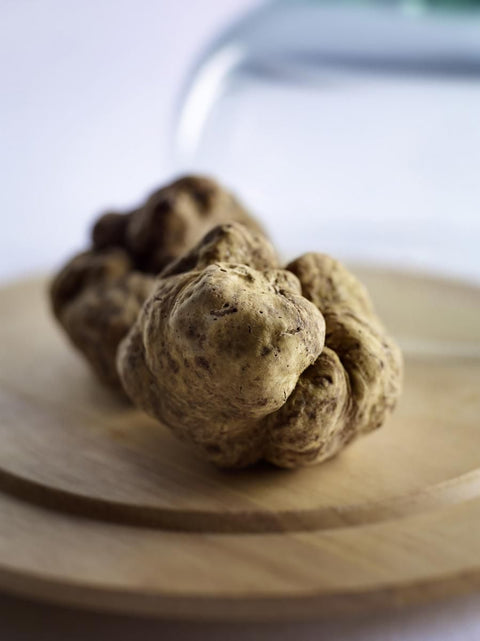 Black summer truffle, also called "Truffe de la Saint-Jean". It looks externally like the black winter truffle but warts are larger and it is beige inside, marbled with white meandriform veins. This is the most common truffle and can be found throughout Europe from May to September. Its aroma is very different and delicate than the black winter truffle, but its lower price and virtually all year availability, makes this truffle a very good choice for testing new recipes. Summer black truffles are great for beginners and experts.
Black summer truffle, also called "Truffe de la Saint-Jean". It looks externally like the black winter truffle but warts are larger and it is beige inside, marbled with white meandriform veins. This is the most common truffle and can be found throughout Europe from May to September. Its aroma is very different and delicate than the black winter truffle, but its lower price and virtually all year availability, makes this truffle a very good choice for testing new recipes. Summer black truffles are great for beginners and experts.
The summer truffle (Tuber aestivum Vitt.) has a rounded and particularly thick skin, meaning that it can be easily distinguished from the black Périgord truffle at first glance. It can reach up to around 10 cm in diameter and is also easy to identify thanks to a small cavity at its base, which is flatter than the rest of it. The colour of its skin ranges from very dark brown to deep black. It is globular in shape, with small pyramidal shaped warts.
Its flesh varies in color from white to ochre and hazel, depending on its ripeness and its area of origin. Truffle hunters seek out the much-appreciated summer truffle from 15 May to 31 August. Unlike other types of truffle, it does not release its aroma immediately. Indeed, a few minutes are needed to fully appreciate its characteristic scent with its subtle fruity notes. It can frequently be found on the surface of the ground and is not predominantly subterranean. It often grows beneath beech and birch trees, as well beneath conifers such as pines and firs.
It grows mainly in conifer woods, at quite high altitudes varying between 1000 and 1400 meters above sea level. Despite its comparatively low cost (compared to other more highly-prized truffle varieties), it is an exquisite accompaniment to meats and rich salads, adding a real touch of sophistication to the menu. Its subtle aroma also recalls the porcini mushroom. Chefs normally use it to add a special touch to traditional Italian dishes, enhancing their aroma.
The Scorzone or Tuber Aestivum, is named after its characteristic rough and bumpy skin. Tasty, more resilient than other varieties, with a less delicate fragrance and taste compared to the Tuber Melanosporum variety, yet popular just the same for its wide array of uses in cooking. It is harvested in the summer, from May to late November. One variety that stands out from the Tuber Aestivum family is the Uncinatum, a truffle harvested from October to December with an intense aroma and a skin and gleba (pulp) that is darker than the ordinary scorzone.




